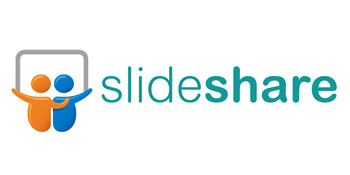 This month, business networking site, LinkedIn announced the acquisition of SlideShare for $118.8 million. SlideShare allows users to upload and share PowerPoint and other slide presentations with business users, either on the Slideshare site or embedded on blogs, websites and shared on Twitter, LinkedIn and Facebook. SlideShare is sometimes known as the “dark horse of B2B marketing”.
This month, business networking site, LinkedIn announced the acquisition of SlideShare for $118.8 million. SlideShare allows users to upload and share PowerPoint and other slide presentations with business users, either on the Slideshare site or embedded on blogs, websites and shared on Twitter, LinkedIn and Facebook. SlideShare is sometimes known as the “dark horse of B2B marketing”.
It’s an interesting move. SlideShare lacks the size of social media sites like Facebook, Twitter, YouTube and LinkedIn, and its growth isn’t anything as remarkable as Pinterest. Certainly SlideShare’s typical content of corporate PowerPoint presentations isn’t capturing the imagination of the popular culture. So why has business networking giant, LinkedIn, decided to shell out $118.8 million in a deal to buy this San Francisco-based company?
The answer, I think, lies in SlideShare’s unique attributes that make it so popular with B2B marketers. First, there are the users. SlideShare users have uploaded more than 9 million presentations since it was founded in 2006. According to comScore, in March, SlideShare had nearly 29 million unique visitors. But it isn’t the number of visitors that’s the real differentiator – it’s the type. SlideShare gets roughly three times the traffic from business owners over the traffic received by other social media sites and it gets about 40% more traffic from C-level executives than LinkedIn. This means that Slideshare is the most heavily trafficked site for professional content and enjoys a unique demographic compared to the rest of the social Web.
Then there’s the content. Moving away from boring slide decks, today’s presenters are influenced by their peers to prepare presentations telling a story that educates and engages. As a result, this content-hosting platform is gaining credibility as a third party provider of information. Here the opinion leader, like a journalist for example, is willing to embed the SlideShare presentation into an article versus embedding the exact same presentation sourced from the business’s web address.
Perhaps the most significant attribute is SlideShare’s premium services. These provide B2B marketers with the ability to view analytics on visitor while building an online presence. For example, premium users can embed lead capture forms with customized fields within their presentations, and then import those leads directly into their own customer relationship management (CRM) systems. This includes integration with third-party marketing automation tools like Eloqua and Salesforce.com.
So we can see that as B2B’s dark horse, SlideShare is all about capturing a unique audience of users, specifically business owners and C-level executives. It offers the ability to upload and host video, customer design, and branding tools. It also facilitates lead capture, detailed analytics and software integration which means that SlideShare delivers one thing other social media sites struggle to provide – a solid return on investment. But how will LinkedIn utilize SlideShare to expand current capabilities and will it transform or be transformed by this union? What do you think?
Marion Guthrie is a marketing practitioner, and a consultant to small and mid-sized business clients. She focuses on helping companies build revenue by developing and executing strategies for customer engagement, in particular marketing plans, budgets, and brand management.




